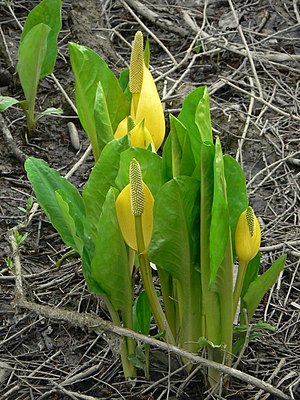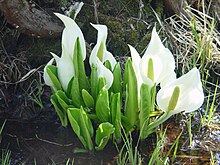Mock call
| Mock call | ||||||||||||
|---|---|---|---|---|---|---|---|---|---|---|---|---|

American skunk cabbage ( Lysichiton americanus ) |
||||||||||||
| Systematics | ||||||||||||
|
||||||||||||
| Scientific name | ||||||||||||
| Lysichiton | ||||||||||||
| Bulkhead |
Scheinkalla ( Lysichiton ), also called Giant Arum , Stinkkohl or Skunkkohl , is a genus of plants with only two species within the Arum family (Araceae).
description

Vegetative characteristics
Lysichiton species grow as deciduous, perennial herbaceous plants . The Asian species is slightly smaller than the American. They form vertical rhizomes as persistence organs . The white roots are contractile.
The basal, upright, large leaves are divided into a petiole and a leaf blade. The petioles are thick and short. The simple leaf blade is elliptical to oblong-egg-shaped or obverse-lanceolate, ends pointed to blunt and has a wedge-shaped to almost truncated base. The main nerves are arranged feathered. The leaves only unfold during or after the flowering period.
Generative characteristics

The flowering time is mainly in early spring. The inflorescence typical of the arum family has no inflorescence stem. Inflorescences of the skunk cabbage species have a bad, indoloid odor (hence the common names). The inflorescence consists of the spathe (single bract ) and the spadix ( piston ). The boat-shaped, bright yellow ( Lysichiton americanus ) or white ( Lysichiton camtschatcensis ) spathe initially completely envelops the piston, the upper area opens wide during the flowering period, only the lower area around the piston stem remains completely closed; it wilts shortly after the individual flowers have faded. The almost cylindrical piston is initially shorter than the spathe, but since its stem grows to seed maturity, the piston protrudes after a while over the spathe. A piston contains numerous small flowers. The hermaphrodite flowers are fourfold. There are four yellowish-green bracts . There are four fertile stamens . The one- or two-chamber usually ovary each chamber contains one or two ovules .
The berries each contain one to four seeds. The green berries are embedded in a white pulpus formed from the spadix.
The basic chromosome number is x = 14.
Occurrence

Lysichiton americanus is native to the North American continent in the Canadian and US states of Alaska and British Columbia , via Idaho , Montana , Oregon , Washington to California at altitudes between 0 and 1400 meters.
Lysichiton camtschatcensis occurs in the Russian areas of Kamchatka , Khabarovsk , the Kuriles , Magadan , Sakhalin and in Japan on Hokkaidō and Honshū .
The two Lysichiton species thrive in swamps, damp forests, along rivers and other slightly damp areas.
Lysichiton americanus is an invasive plant in some areas in Europe .
Systematics
The first publication of this kind took place in 1857 by Heinrich Wilhelm Schott in Oesterreichisches Botanical weekly , 7, page 62 under the name Lysichitum . For a long time it remained a monotypical genus with the only species Lysichitum camtschatcense , which was first published by Carl von Linné as Dracontium camtschatcense L. It was not until 1931 that the American population was separated from the Asian population with the new description of Lysichiton americanus by Eric Hultén and Harold St. John in The American species of Lysichitum , in Svensk Botanisk Tidskrift , 25, p. 455. Originally the name Lysichitum camtschatcense was for both populations used in North America and Asia; they differ essentially in the yellow and white spathe.
The botanical generic name Lysichiton is derived from the Greek words lysis for dissolving, unfolding and chiton for shell, this refers to the spathe.
The genus Lysichiton therefore only contains two species:
- American skunk cabbage , yellow calf calla, American giant aaron ( Lysichiton americanus Hultén & H.St.John )
- White lysichiton , Asian skunk cabbage, Asian Skunk Cabbage, Kamchatka Bistort ( Lysichiton camtschatcensis Hultén & H.St.John , Syn. : Dracontium camtschatcense L., Lysichiton album Makino , Lysichiton japonicus (A. Gray) Schott ex Miq. , Lysichitum camtschatcense ( L.) Schott )
Note: the common name skunk cabbage is also used for Symplocarpus foetidus (L.) Nutt. used.
use
Both types of Lysichiton are used as ornamental plants for ponds.
Almost all parts of the Lysichiton americanus plant were used by the indigenous peoples of North America as food or for medicinal purposes. The underground parts of the plant are called poisonous.
literature
- Sue A. Thompson: Araceae in the Flora of North America , Volume 22, 2000: Lysichiton - Online. (Section description, systematics and dissemination)
Individual evidence
- ↑ R. Fuchs, H. Kutzelnigg, GB Feige, P. Keil: Wild occurrences of Lysichiton americanus Hultén & St. John (Araceae) in Duisburg and Mülheim an der Ruhr. , In: Tuexenia 23, 2003, pp. 373-379: changed online.
- ↑ a b Rafaël Govaerts (Ed.): Lysichiton. In: World Checklist of Selected Plant Families (WCSP) - The Board of Trustees of the Royal Botanic Gardens, Kew . Retrieved June 17, 2018.
- ↑ a b Entry in Neoflora by FloraWeb .
- ^ Sue A. Thompson: Araceae in the Flora of North America , Volume 22, 2000: Lysichiton - Online.
- ^ Daniel E. Moerman: Native American medicinal plants: an ethnobotanical dictionary , Timber Press, 2009 ISBN 9780881929874 : Google Books Online. Lysichiton americanus on p. 290.